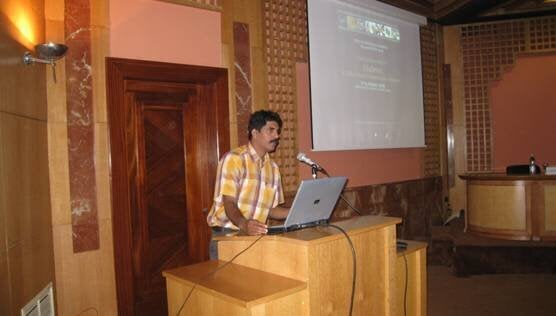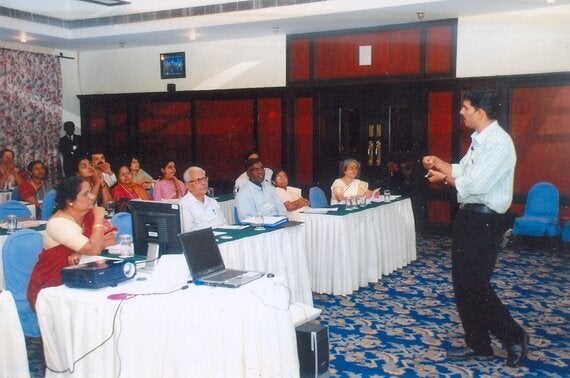Dr. Jayakrishnan Thavody is the associate professor of community medicine at Government Medical College, Kozhikode. In this interview, Dr. Jayakrishnan speaks about his experiences in dealing with polio eradication in the state of Kerala in India. Thanks to the efforts of millions of healthcare workers, India was declared as polio-free in 2014.
Dr. Jayakrishnan's efforts to combat polio dates back to 2000 when he was a post graduate student in community medicine. He was appointed as the external monitor for pulse polio program by the World Health Organization (WHO). The pulse polio program is a government-led initiative in India for eradicating poliomyelitis by administering oral polio vaccine to all children under the age of five, irrespective of their past immunization status. He worked with two other monitors and reported the ground situation of polio in Kerala directly to the WHO. Health analysts attribute successful eradication of polio to the Pulse Polio Immunisation program.
The pulse polio program in India works under strict supervision. On day 1, parents bring their under-5 children for vaccination to the designated vaccination booths. Oral polio vaccines would be administered to them by the vaccinators. On day 2 and 3, vaccinators visit the houses of children who have missed out immunization on the pulse polio day. Afterwards, volunteers classify the houses as protected (X) and unvaccinated (P). The houses of vaccinated children will be marked with a P and those of unvaccinated children will be marked with an X. The number of houses marked with P and X will act as indicators for checking the efficiency of the program.
Dr. Jayakrishnan recalls that myths regarding polio vaccination was rampant in the 2000s. Some people thought that their children will be crippled by vaccination, others believed that their children's fertility will be affected by the vaccine. There were people who thought that the delivery of the vaccine was a part of an international conspiracy deliberately designed to target Indian children. In some parts of Kerala, there were outcries that discarded vaccines were being administered to the children.
The healthcare workers adopted various strategies to bust these myths. One of them was to involve religious and political leaders in advocating for immunization. However, it was curious to note that if one of the religious sects supported vaccination, other sects with opposing ideology invariably opposed it. The health workers also distributed pamphlets describing the benefits of vaccination to educate the parents. Eventually, nearly all children started participating in the vaccination program by 2000s.
It was in 2014 that India eradicated polio. Dr. Jayakrishnan believes that it would have been possible to achieve this status a few years ago if the groundwork and research were done a little earlier. But he sees that there are many challenges unique to India : geographical, cultural and political. India took a bit longer to be free of polio because, in addition to the limitations in infrastructure, the health workers had to deal with these additional challenges. Oral polio vaccine, being sensitive to heat, needs to be maintained under refrigeration to keep it viable. But in some Indian villages, where electricity is limited or even non-existent, it is hard to maintain refrigeration. The healthcare strategists in India had to find solutions for such infrastructural issues in addition to the issues related to transport, storage, administration and monitoring - all under a limited budget. In India, we achieved eradication status by learning from past mistakes, identifying focus areas where polio is rampant and by adopting cost-effective policies.

Dr. Jayakrishnan during an academic event. Image credit: Dr. Jayakrishnan, 2014.
Dr. Jayakrishnan recalls that developed countries had conquered polio by around 1995. During that time, the Indian subcontinent still had the disease - in fact, polio is still being reported in Pakistan and Afghanistan. Though polio was reported from all over the world in large numbers prior to the introduction of vaccines, it was commoner in the Indian subcontinent because of poor sanitation and limited availability of safe drinking water. However, providing its citizens with these facilities would require a greater effort, and India could not wait as long to eradicate polio. This was how the idea of using oral polio vaccine as a primary tool to control polio came into being.
Dr. Jayakrishnan remembers an incident of operational fatigue prior to 2000 when government doctors demanded that vaccination be stopped in Kerala because there are no cases of polio being reported for a long time. A confirmed case of polio was reported in the year 2000, which startled all health workers to more actively involved in the campaigns against polio. No further cases of polio were reported in Kerala after 2000. Thereafter, there was no incidence of resistance from health workers in Kerala.
In India, every case of sudden flaccid paralysis in children under 15 or muscle weakness in anyone whom polio is suspected is followed up with extreme suspicion. The stool samples of the patient is tested for poliovirus at one of the eight WHO accredited labs and he/she is put under observation for forty days. Environmental surveillance includes testing for polio virus in sewage samples and other water bodies. When asked if the existing system of polio surveillance causes unnecessary panic to the public, Dr. Jayakrishnan replies that the present system of aggressive surveillance for polio is necessary as we cannot take any chances in case of such a deadly disease for which so much of effort has gone into its eradication. The surveillance system is also reassuring for the public that the country will remain free of polio in the long run. "No amount of vigilance would be over-vigilance", Dr. Jayakrishnan adds.

Dr. Jayakrishnan speaking to an audience at a conference, Image credit: Dr. Jayakrishnan, 2014.
Though the ministry of health and family welfare in India played the prime role in running this program, generous support was received from non-governmental organizations, international partners and volunteers in terms of financial assistance and manpower. Most of all volunteers of the pulse polio program were not medical professionals. They were trained in all aspects of management of the vaccination program and were supervised by medical professionals while on duty.
Now that India has become polio free, the live oral polio vaccine (which contains three types of weakened polio viruses) is to be replaced with the killed injectable polio vaccine. It is not an easy step, but Dr. Jayakrishnan is confident that like the past successful efforts to combat polio, this change of vaccines can also be accommodated smoothly with proper planning and implementation. The shift to injectable polio vaccine will also ensure that there are no cases of vaccine associated paralytic polio. As of now, the risk of vaccine associated paralytic polio is one in 1,50,000 babies. "There is always a threat of import of polio cases to India especially when neighbouring countries like Pakistan and Afganistan have reported polio cases. Only when all the countries in the world are declared free of polio can we confidently say that polio is eradicated from the world", observes Dr. Jayakrishnan.